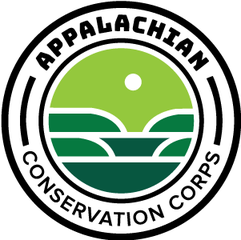Invasive Plant Management Team Finishes Season; Applications for 2024 Cohort Now Open
Individual PlacementsBy Laura Boaggio
Nov. 21st, 2023 | Washington, D.C. — Similar to weeding a garden, our federal and state parks need to be maintained to keep local flora and fauna healthy. While it may sound like a simple task, those weeds can grow far and wide — and sometimes take more than a pair of hands to get rid of.
This winter, four of Appalachian Conservation Corps’ Individual Placements will finish up their service work with the Invasive Plant Management team, which is based out of Washington, D.C. Since February, they have helped control invasive plant species using mechanical and chemical methods throughout the National Capital Region, which includes parks in Maryland, Virginia and West Virginia.
Since colonization began in North America, plant and animal species from across the world have been introduced into the continent. Invasive species can lead to the extinction of native plants and animals, destroy biodiversity, and permanently alter habitats. For hundreds of years, invasive species have been able to thrive in this new ecosystem without their natural checks and balances. The Invasive Plant Management team is one of many across the U.S. working to manage or eradicate invasive species in ecologically important sites to make space for native species.
Information provided by the U.S. Department of Agriculture.
Throughout their service term, the team navigated cliff sides, dressed in chest waders for wet marshes, and wandered the woods with backpack sprayers, gas-operated tank sprayers and hand tools to get the job done.
“Our camaraderie grew and the difficult field work became bonding experiences,” ACC member Veronica said. “We learned to anticipate each other’s needs and work extremely well together, and I felt like I was a valuable part of a well-oiled machine.”
The Invasive Plant Management team scaling a cliff while treating invasives with backpack sprayers.
One of the aquatic treatments the team helped with was eradicating giant reed in the Roaches Run Waterfowl Sanctuary as part of a long-term project to restore the natural wetland.
The team tackled over 20 invasive plant species, with some of the major contenders being fig buttercup (lesser celandine), incised fumewort (corydalis incisa), Italian arum (arum italicum), fountain grass (cenchrus alopecuroides), common reed (phragmites australis), tree-of-heaven (ailanthis altissima), wavyleaf basketgrass (oplismenus undulatifolius), and autumn olive (Elaeagnus umbellata) — among others.
Some plants like fig buttercup were widespread and covered the ground like a blanket, while other species like Italian arum were few and far between.
The crew sprayed plants when they could, but some greenery had a thick texture that required a stronger herbicide or hand-pulling to fully eradicate it. For especially hardy invasives like autumn olive and honey locust, they broke out the chainsaw.
ACC member Matthew preparing to chainsaw a patch of autumn olive.
To prepare for the season, members attained their pesticide applicator license in three states and D.C., got chainsaw certified, and trained on GIS and map navigation at the beginning of their term. Additionally, they were certified in CPR and First Aid.
Oftentimes, the crew sprayed invasive plants using a tank sprayer on their truck, which was no small feat. The tank engine required calibration and the right mix of herbicide to operate. The team also mapped areas before and after treating, which taught them how to use GIS software.
ACC members Matthew and Veronica preparing herbicide in a work truck.
Throughout the year, the team treated sites at Rock Creek Park, Chesapeake and Ohio Canal National Historical Park, Catoctin Mountain Park, Manassas National Battlefield and Harper’s Ferry National Historical Park, just to name a few.
One persistent invasive they helped treat against was the woolly adelgid insect that has been attacking Hemlock trees in the eastern U.S. since it was first reported in Virginia in the early 1950s. To do this, they injected Hemlock trees with an insecticide to protect the tree’s health.
Another insect they fought was the spotted lanternfly, which has been threatening fruit crops and trees in the eastern U.S. since it was first spotted in Pennsylvania in 2014.
The team sometimes found itself working in residential areas. Seeing folks in National Park Service outfits tending to their yards made residents feel like their backyards mattered, some members said.
“We were specifically working to manage invasive plants to improve the native ecology at these sites, but people that live in these neighborhoods that came to talk to us about the work generally saw it as the park service caring about them and the space they call home,” Veronica said. “To be a part of this is to care not only about environmental stewardship, but about community awareness and betterment.”
Invasive plants can be hard to identify, but it’s likely there are a few growing in your backyard. Read here for more information about invasive plant species in the Mid-Atlantic, resources on invasive plants in Virginia, and common invasive plant species in Maryland.
ACC members Matthew and Veronica examining garlic mustard.
As much as ACC is a conservation organization, we also serve as a professional development opportunity for young adults. The Invasive Plant Management team took turns acting as functional leaders throughout their term to lead the group on projects. The team also helped with other tasks, such as joining a biologist at Prince William Forest Park to set up wildlife cameras to study animals such as black bears and deer.
One of this year’s members, Micki, secured a job as an Urban Forester with the District Department of Transportation immediately following her end date with ACC. In this position, she will inspect, evaluate and manage urban tree populations to continue protecting species in the D.C. area.
ACC member Micki in the field.
With three out of four members graduated, ACC member Jael will continue his team’s work in D.C. before finishing up in January. He will focus on inventorying and preparing for the next team, which begins service in February.
Applications for the 2024 Invasive Plant Management team are now open on ACC’s website. Click here to read more about the position and apply to join next year’s team!
You can learn more about invasive species of the Mid-Atlantic region with this field guide created in partnership with the National Park Service and Fish and Wildlife Service.
ACC members Jael, Micki and Veronica pose with Yvonne (Community Volunteer Ambassador) at The Corps Network’s Great Outdoors Day of Service event in Washington, D.C. on June 16, 2023.
ACC members Micki, Matthew and Veronica pose for a picture with National Park Service staff.





